Abstract
The coding coenzyme handle hypothesis suggests that useful coding preceded translation. Early adapters, the ancestors of present-day anticodons, were charged with amino acids acting as coenzymes of ribozymes in a metabolically complex RNA world. The ancestral aminoacyl-adapter synthetases could have been similar to present-day self-splicing tRNA introns. A codon-anticodon-discriminator base complex embedded in these synthetases could have played an important role in amino acid recognition. Extension of the genetic code proceeded through the take-over of nonsense codons by novel amino acids, related to already coded ones either through precursor-product relationship or physicochemical similarity. The hypothesis is open for experimental tests.
Full text
PDF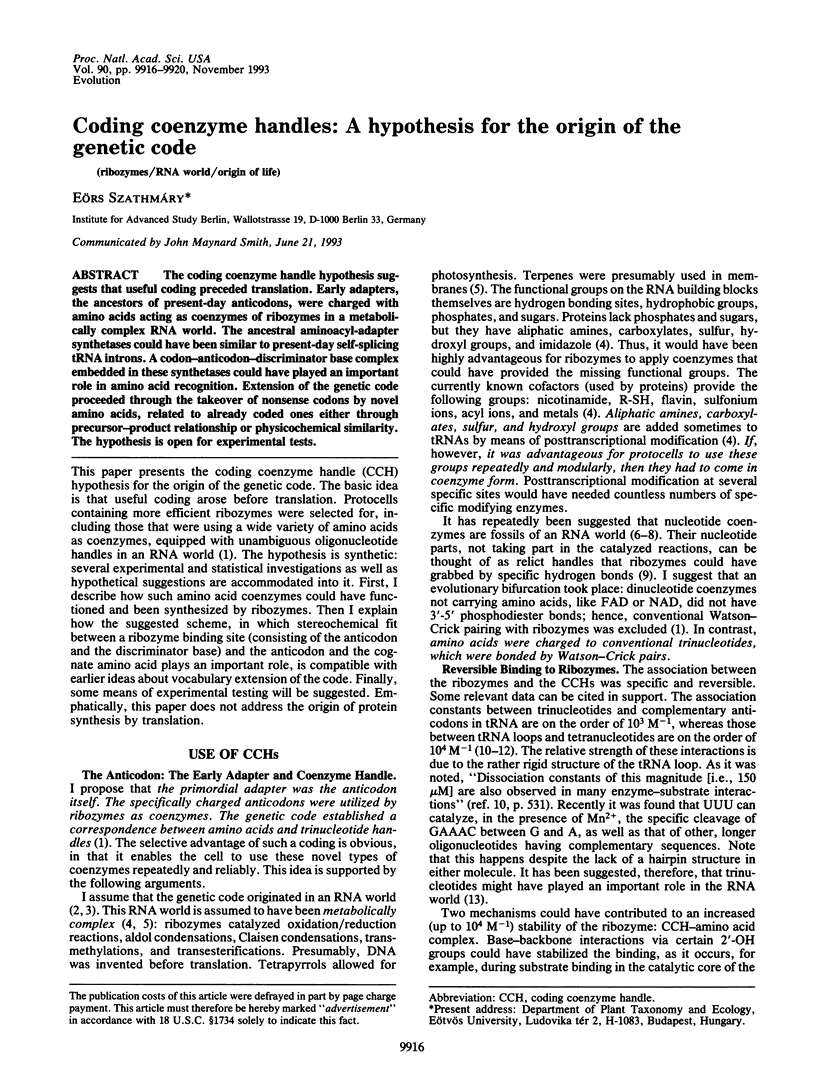
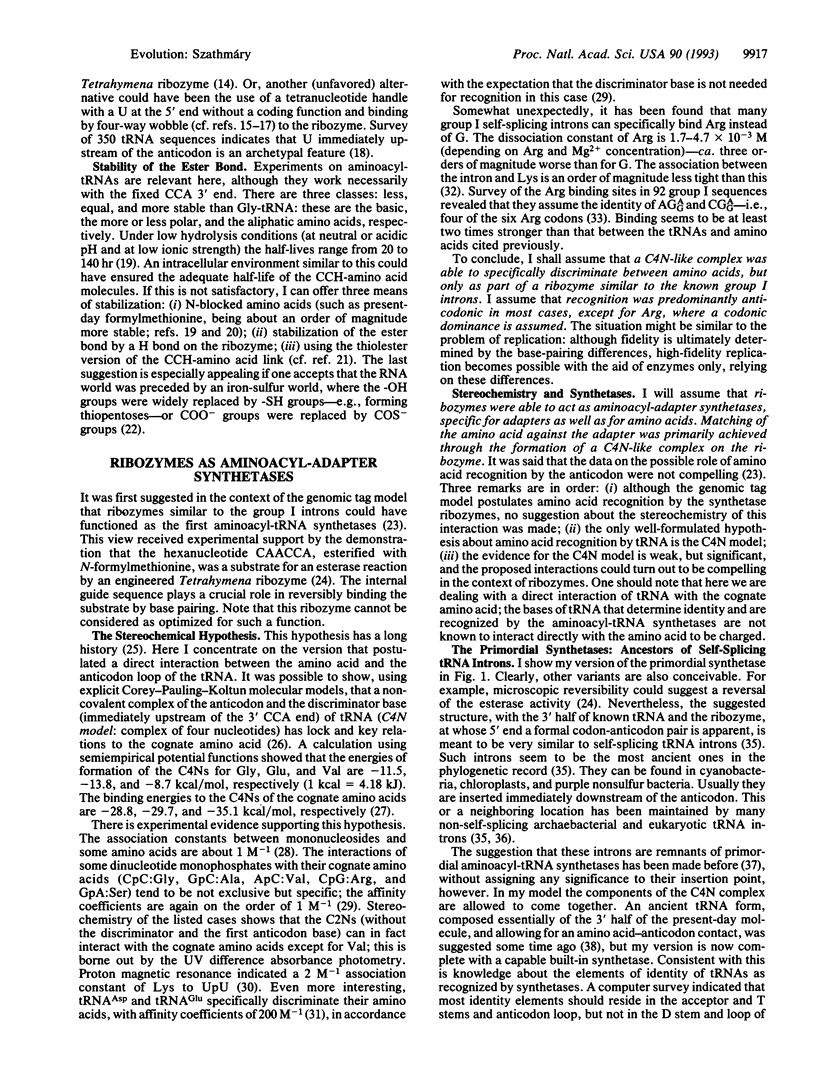
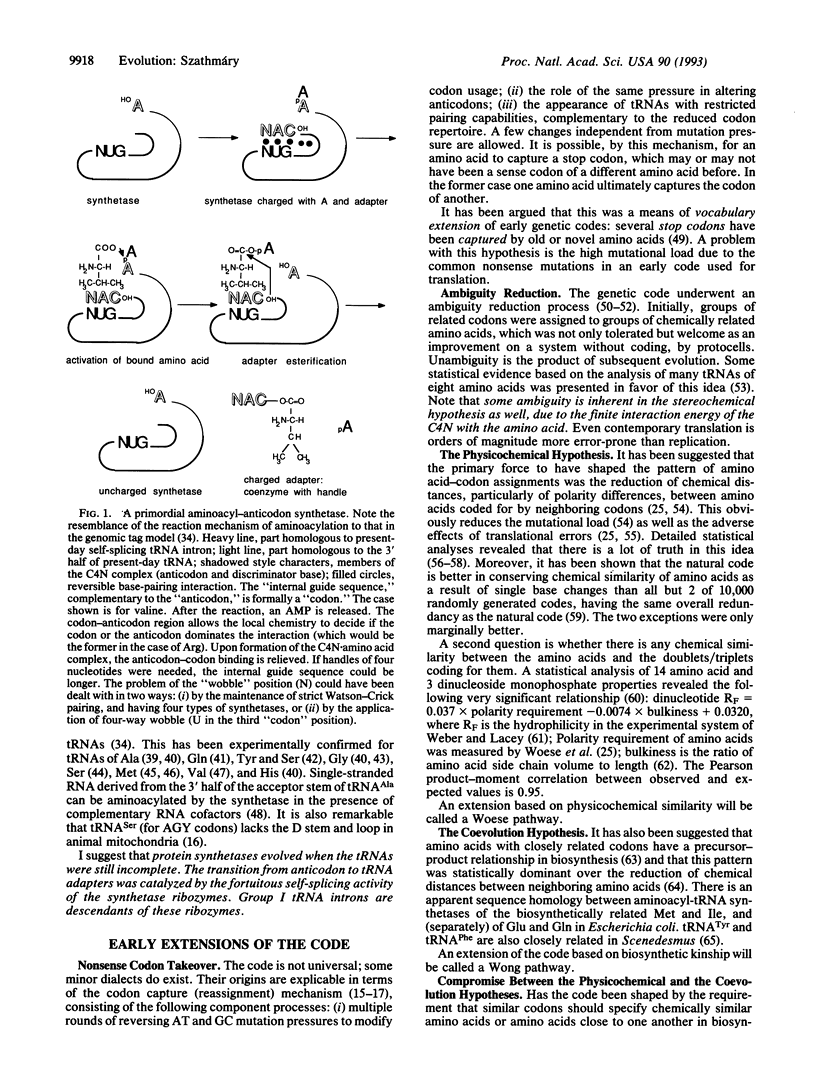
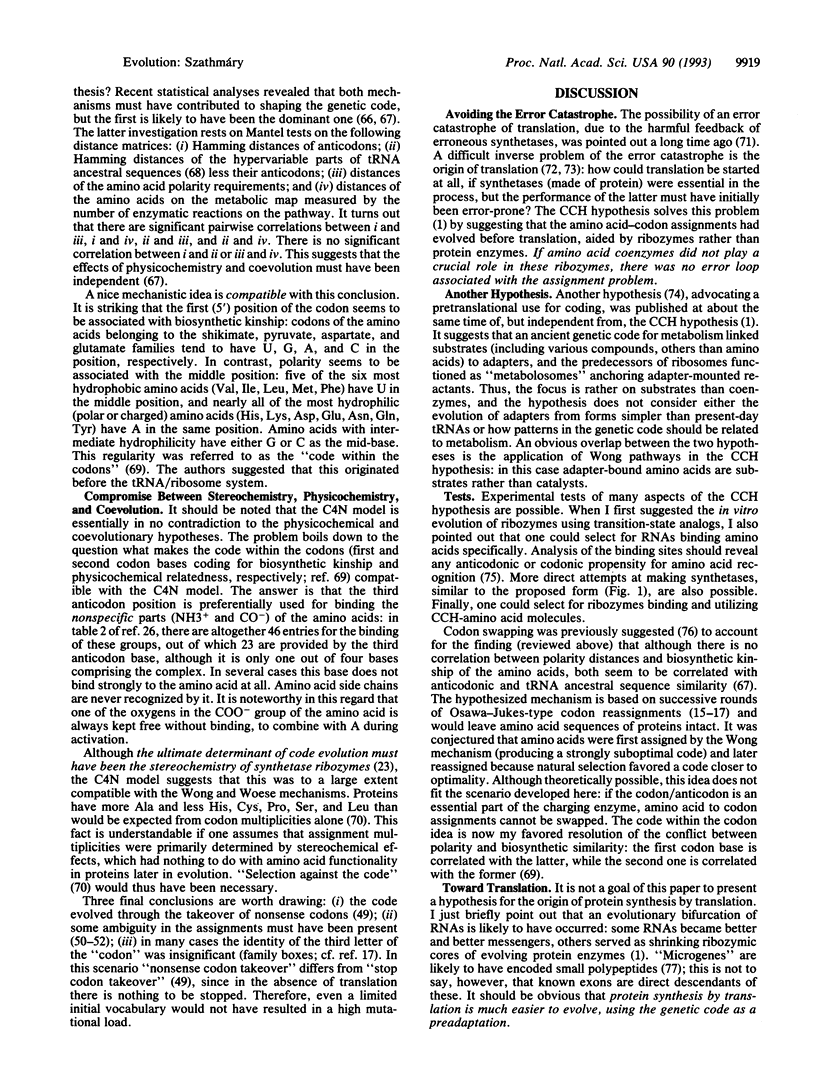
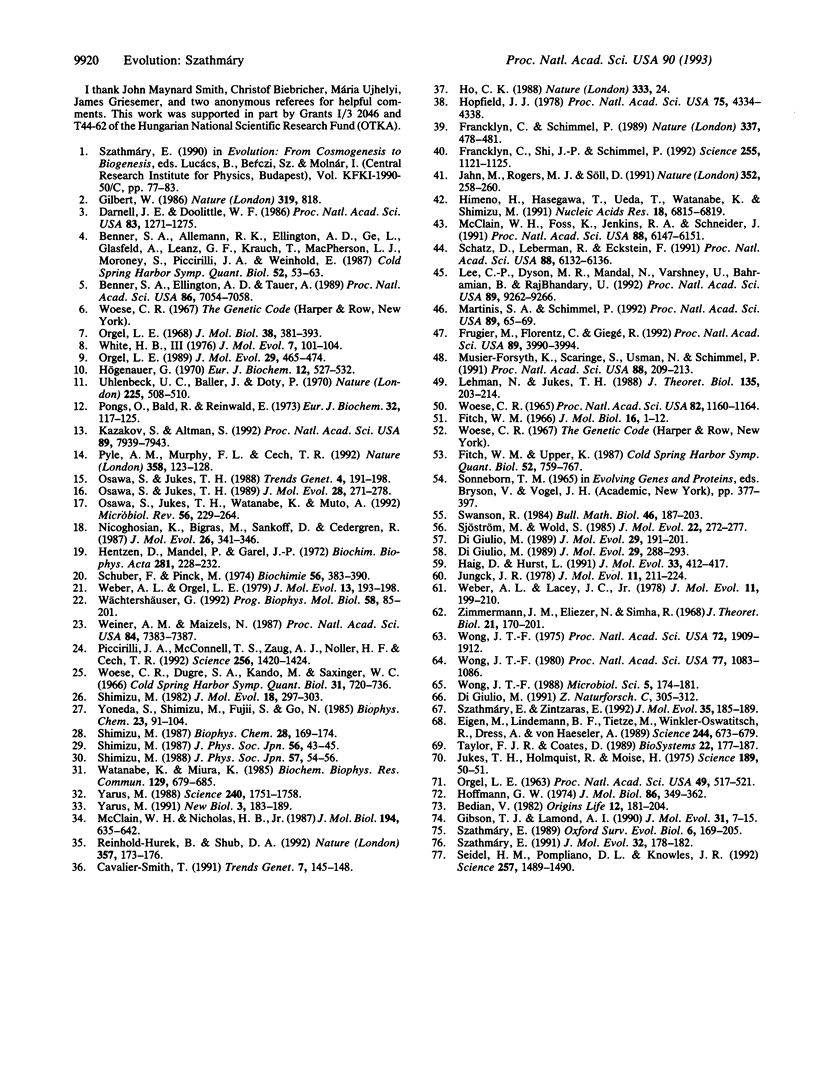
Selected References
These references are in PubMed. This may not be the complete list of references from this article.
- Bedian V. The possible role of assignment catalysts in the origin of the genetic code. Orig Life. 1982 Jun;12(2):181–204. doi: 10.1007/BF00927144. [DOI] [PubMed] [Google Scholar]
- Benner S. A., Allemann R. K., Ellington A. D., Ge L., Glasfeld A., Leanz G. F., Krauch T., MacPherson L. J., Moroney S., Piccirilli J. A. Natural selection, protein engineering, and the last riboorganism: rational model building in biochemistry. Cold Spring Harb Symp Quant Biol. 1987;52:53–63. doi: 10.1101/sqb.1987.052.01.009. [DOI] [PubMed] [Google Scholar]
- Benner S. A., Ellington A. D., Tauer A. Modern metabolism as a palimpsest of the RNA world. Proc Natl Acad Sci U S A. 1989 Sep;86(18):7054–7058. doi: 10.1073/pnas.86.18.7054. [DOI] [PMC free article] [PubMed] [Google Scholar]
- Cavalier-Smith T. Intron phylogeny: a new hypothesis. Trends Genet. 1991 May;7(5):145–148. [PubMed] [Google Scholar]
- Darnell J. E., Doolittle W. F. Speculations on the early course of evolution. Proc Natl Acad Sci U S A. 1986 Mar;83(5):1271–1275. doi: 10.1073/pnas.83.5.1271. [DOI] [PMC free article] [PubMed] [Google Scholar]
- Di Giulio M. The extension reached by the minimization of the polarity distances during the evolution of the genetic code. J Mol Evol. 1989 Oct;29(4):288–293. doi: 10.1007/BF02103616. [DOI] [PubMed] [Google Scholar]
- Eigen M., Lindemann B. F., Tietze M., Winkler-Oswatitsch R., Dress A., von Haeseler A. How old is the genetic code? Statistical geometry of tRNA provides an answer. Science. 1989 May 12;244(4905):673–679. doi: 10.1126/science.2497522. [DOI] [PubMed] [Google Scholar]
- Fitch W. M., Upper K. The phylogeny of tRNA sequences provides evidence for ambiguity reduction in the origin of the genetic code. Cold Spring Harb Symp Quant Biol. 1987;52:759–767. doi: 10.1101/sqb.1987.052.01.085. [DOI] [PubMed] [Google Scholar]
- Francklyn C., Schimmel P. Aminoacylation of RNA minihelices with alanine. Nature. 1989 Feb 2;337(6206):478–481. doi: 10.1038/337478a0. [DOI] [PubMed] [Google Scholar]
- Francklyn C., Shi J. P., Schimmel P. Overlapping nucleotide determinants for specific aminoacylation of RNA microhelices. Science. 1992 Feb 28;255(5048):1121–1125. doi: 10.1126/science.1546312. [DOI] [PubMed] [Google Scholar]
- Frugier M., Florentz C., Giegé R. Anticodon-independent aminoacylation of an RNA minihelix with valine. Proc Natl Acad Sci U S A. 1992 May 1;89(9):3990–3994. doi: 10.1073/pnas.89.9.3990. [DOI] [PMC free article] [PubMed] [Google Scholar]
- Gibson T. J., Lamond A. I. Metabolic complexity in the RNA world and implications for the origin of protein synthesis. J Mol Evol. 1990 Jan;30(1):7–15. doi: 10.1007/BF02102448. [DOI] [PubMed] [Google Scholar]
- Haig D., Hurst L. D. A quantitative measure of error minimization in the genetic code. J Mol Evol. 1991 Nov;33(5):412–417. doi: 10.1007/BF02103132. [DOI] [PubMed] [Google Scholar]
- Hentzen D., Mandel P., Garel J. P. Relation between aminoacyl-tRNA stability and the fixed amino acid. Biochim Biophys Acta. 1972 Oct 11;281(2):228–232. doi: 10.1016/0005-2787(72)90174-8. [DOI] [PubMed] [Google Scholar]
- Himeno H., Hasegawa T., Ueda T., Watanabe K., Shimizu M. Conversion of aminoacylation specificity from tRNA(Tyr) to tRNA(Ser) in vitro. Nucleic Acids Res. 1990 Dec 11;18(23):6815–6819. doi: 10.1093/nar/18.23.6815. [DOI] [PMC free article] [PubMed] [Google Scholar]
- Ho C. K. Primitive ancestry of transfer RNA. Nature. 1988 May 5;333(6168):24–24. doi: 10.1038/333024a0. [DOI] [PubMed] [Google Scholar]
- Hoffmann G. W. On the origin of the genetic code and the stability of the translation apparatus. J Mol Biol. 1974 Jun 25;86(2):349–362. doi: 10.1016/0022-2836(74)90024-2. [DOI] [PubMed] [Google Scholar]
- Hopfield J. J. Origin of the genetic code: a testable hypothesis based on tRNA structure, sequence, and kinetic proofreading. Proc Natl Acad Sci U S A. 1978 Sep;75(9):4334–4338. doi: 10.1073/pnas.75.9.4334. [DOI] [PMC free article] [PubMed] [Google Scholar]
- Högenauer G. The stability of a codon transfer RNA complex. Eur J Biochem. 1970 Feb;12(3):527–532. doi: 10.1111/j.1432-1033.1970.tb00882.x. [DOI] [PubMed] [Google Scholar]
- Jahn M., Rogers M. J., Söll D. Anticodon and acceptor stem nucleotides in tRNA(Gln) are major recognition elements for E. coli glutaminyl-tRNA synthetase. Nature. 1991 Jul 18;352(6332):258–260. doi: 10.1038/352258a0. [DOI] [PubMed] [Google Scholar]
- Jukes T. H., Holmquist R., Moise H. Amino acid composition of proteins: Selection against the genetic code. Science. 1975 Jul 4;189(4196):50–51. doi: 10.1126/science.237322. [DOI] [PubMed] [Google Scholar]
- Jungck J. R. The genetic code as a periodic table. J Mol Evol. 1978 Aug 2;11(3):211–224. doi: 10.1007/BF01734482. [DOI] [PubMed] [Google Scholar]
- Kazakov S., Altman S. A trinucleotide can promote metal ion-dependent specific cleavage of RNA. Proc Natl Acad Sci U S A. 1992 Sep 1;89(17):7939–7943. doi: 10.1073/pnas.89.17.7939. [DOI] [PMC free article] [PubMed] [Google Scholar]
- Lee C. P., Dyson M. R., Mandal N., Varshney U., Bahramian B., RajBhandary U. L. Striking effects of coupling mutations in the acceptor stem on recognition of tRNAs by Escherichia coli Met-tRNA synthetase and Met-tRNA transformylase. Proc Natl Acad Sci U S A. 1992 Oct 1;89(19):9262–9266. doi: 10.1073/pnas.89.19.9262. [DOI] [PMC free article] [PubMed] [Google Scholar]
- Lehman N., Jukes T. H. Genetic code development by stop codon takeover. J Theor Biol. 1988 Nov 21;135(2):203–214. doi: 10.1016/s0022-5193(88)80074-2. [DOI] [PubMed] [Google Scholar]
- Martinis S. A., Schimmel P. Enzymatic aminoacylation of sequence-specific RNA minihelices and hybrid duplexes with methionine. Proc Natl Acad Sci U S A. 1992 Jan 1;89(1):65–69. doi: 10.1073/pnas.89.1.65. [DOI] [PMC free article] [PubMed] [Google Scholar]
- McClain W. H., Foss K., Jenkins R. A., Schneider J. Rapid determination of nucleotides that define tRNA(Gly) acceptor identity. Proc Natl Acad Sci U S A. 1991 Jul 15;88(14):6147–6151. doi: 10.1073/pnas.88.14.6147. [DOI] [PMC free article] [PubMed] [Google Scholar]
- McClain W. H., Nicholas H. B., Jr Differences between transfer RNA molecules. J Mol Biol. 1987 Apr 20;194(4):635–642. doi: 10.1016/0022-2836(87)90240-3. [DOI] [PubMed] [Google Scholar]
- Musier-Forsyth K., Scaringe S., Usman N., Schimmel P. Enzymatic aminoacylation of single-stranded RNA with an RNA cofactor. Proc Natl Acad Sci U S A. 1991 Jan 1;88(1):209–213. doi: 10.1073/pnas.88.1.209. [DOI] [PMC free article] [PubMed] [Google Scholar]
- Nicoghosian K., Bigras M., Sankoff D., Cedergren R. Archetypical features in tRNA families. J Mol Evol. 1987;26(4):341–346. doi: 10.1007/BF02101153. [DOI] [PubMed] [Google Scholar]
- ORGEL L. E. The maintenance of the accuracy of protein synthesis and its relevance to ageing. Proc Natl Acad Sci U S A. 1963 Apr;49:517–521. doi: 10.1073/pnas.49.4.517. [DOI] [PMC free article] [PubMed] [Google Scholar]
- Orgel L. E. Evolution of the genetic apparatus. J Mol Biol. 1968 Dec;38(3):381–393. doi: 10.1016/0022-2836(68)90393-8. [DOI] [PubMed] [Google Scholar]
- Orgel L. E. The origin of polynucleotide-directed protein synthesis. J Mol Evol. 1989 Dec;29(6):465–474. doi: 10.1007/BF02602917. [DOI] [PubMed] [Google Scholar]
- Osawa S., Jukes T. H. Codon reassignment (codon capture) in evolution. J Mol Evol. 1989 Apr;28(4):271–278. doi: 10.1007/BF02103422. [DOI] [PubMed] [Google Scholar]
- Osawa S., Jukes T. H. Evolution of the genetic code as affected by anticodon content. Trends Genet. 1988 Jul;4(7):191–198. doi: 10.1016/0168-9525(88)90075-3. [DOI] [PubMed] [Google Scholar]
- Osawa S., Jukes T. H., Watanabe K., Muto A. Recent evidence for evolution of the genetic code. Microbiol Rev. 1992 Mar;56(1):229–264. doi: 10.1128/mr.56.1.229-264.1992. [DOI] [PMC free article] [PubMed] [Google Scholar]
- Piccirilli J. A., McConnell T. S., Zaug A. J., Noller H. F., Cech T. R. Aminoacyl esterase activity of the Tetrahymena ribozyme. Science. 1992 Jun 5;256(5062):1420–1424. doi: 10.1126/science.1604316. [DOI] [PubMed] [Google Scholar]
- Pongs O., Bald R., Reinwald E. On the structure of yeast tRNA Phe . Complementary-oligonucleotide binding studies. Eur J Biochem. 1973 Jan 3;32(1):117–125. doi: 10.1111/j.1432-1033.1973.tb02586.x. [DOI] [PubMed] [Google Scholar]
- Pyle A. M., Murphy F. L., Cech T. R. RNA substrate binding site in the catalytic core of the Tetrahymena ribozyme. Nature. 1992 Jul 9;358(6382):123–128. doi: 10.1038/358123a0. [DOI] [PubMed] [Google Scholar]
- Reinhold-Hurek B., Shub D. A. Self-splicing introns in tRNA genes of widely divergent bacteria. Nature. 1992 May 14;357(6374):173–176. doi: 10.1038/357173a0. [DOI] [PubMed] [Google Scholar]
- Schatz D., Leberman R., Eckstein F. Interaction of Escherichia coli tRNA(Ser) with its cognate aminoacyl-tRNA synthetase as determined by footprinting with phosphorothioate-containing tRNA transcripts. Proc Natl Acad Sci U S A. 1991 Jul 15;88(14):6132–6136. doi: 10.1073/pnas.88.14.6132. [DOI] [PMC free article] [PubMed] [Google Scholar]
- Schuber F., Pinck M. On the chemical reactivity of aminoacyl-tRNA ester bond. I. Influence of pH and nature of the acyl group on the rate of hydrolysis. Biochimie. 1974;56(3):383–390. doi: 10.1016/s0300-9084(74)80146-x. [DOI] [PubMed] [Google Scholar]
- Seidel H. M., Pompliano D. L., Knowles J. R. Exons as microgenes? Science. 1992 Sep 11;257(5076):1489–1490. doi: 10.1126/science.1523407. [DOI] [PubMed] [Google Scholar]
- Shimizu M. Molecular basis for the genetic code. J Mol Evol. 1982;18(5):297–303. doi: 10.1007/BF01733895. [DOI] [PubMed] [Google Scholar]
- Shimizu M. Precise ultraviolet absorbance study of the interactions of amino acids and mononucleosides in aqueous solution. Biophys Chem. 1987 Nov;28(2):169–174. doi: 10.1016/0301-4622(87)80086-8. [DOI] [PubMed] [Google Scholar]
- Sjöström M., Wold S. A multivariate study of the relationship between the genetic code and the physical-chemical properties of amino acids. J Mol Evol. 1985;22(3):272–277. doi: 10.1007/BF02099756. [DOI] [PubMed] [Google Scholar]
- Swanson R. A unifying concept for the amino acid code. Bull Math Biol. 1984;46(2):187–203. doi: 10.1007/BF02460068. [DOI] [PubMed] [Google Scholar]
- Uhlenbeck O. C., Baller J., Doty P. Complementary oligonucleotide binding to the anticodon loop of fMet-transfer RNA. Nature. 1970 Feb 7;225(5232):508–510. doi: 10.1038/225508a0. [DOI] [PubMed] [Google Scholar]
- Watanabe K., Miura K. Specific interaction between tRNA and its cognate amino acid as detected by circular dichroism and fluorescence spectroscopy. Biochem Biophys Res Commun. 1985 Jun 28;129(3):679–685. doi: 10.1016/0006-291x(85)91945-x. [DOI] [PubMed] [Google Scholar]
- Weber A. L., Lacey J. C., Jr Genetic code correlations: amino acids and their anticodon nucleotides. J Mol Evol. 1978 Aug 2;11(3):199–210. doi: 10.1007/BF01734481. [DOI] [PubMed] [Google Scholar]
- Weber A. L., Orgel L. E. The formation of peptides from glycine thioesters. J Mol Evol. 1979 Oct;13(3):193–202. doi: 10.1007/BF01739479. [DOI] [PubMed] [Google Scholar]
- Weiner A. M., Maizels N. tRNA-like structures tag the 3' ends of genomic RNA molecules for replication: implications for the origin of protein synthesis. Proc Natl Acad Sci U S A. 1987 Nov;84(21):7383–7387. doi: 10.1073/pnas.84.21.7383. [DOI] [PMC free article] [PubMed] [Google Scholar]
- White H. B., 3rd Coenzymes as fossils of an earlier metabolic state. J Mol Evol. 1976 Mar 29;7(2):101–104. doi: 10.1007/BF01732468. [DOI] [PubMed] [Google Scholar]
- Woese C. R., Dugre D. H., Dugre S. A., Kondo M., Saxinger W. C. On the fundamental nature and evolution of the genetic code. Cold Spring Harb Symp Quant Biol. 1966;31:723–736. doi: 10.1101/sqb.1966.031.01.093. [DOI] [PubMed] [Google Scholar]
- Wong J. T. A co-evolution theory of the genetic code. Proc Natl Acad Sci U S A. 1975 May;72(5):1909–1912. doi: 10.1073/pnas.72.5.1909. [DOI] [PMC free article] [PubMed] [Google Scholar]
- Wong J. T. Role of minimization of chemical distances between amino acids in the evolution of the genetic code. Proc Natl Acad Sci U S A. 1980 Feb;77(2):1083–1086. doi: 10.1073/pnas.77.2.1083. [DOI] [PMC free article] [PubMed] [Google Scholar]
- Wächtershäuser G. Groundworks for an evolutionary biochemistry: the iron-sulphur world. Prog Biophys Mol Biol. 1992;58(2):85–201. doi: 10.1016/0079-6107(92)90022-x. [DOI] [PubMed] [Google Scholar]
- Yarus M. A specific amino acid binding site composed of RNA. Science. 1988 Jun 24;240(4860):1751–1758. doi: 10.1126/science.3381099. [DOI] [PubMed] [Google Scholar]
- Yarus M. An RNA-amino acid complex and the origin of the genetic code. New Biol. 1991 Feb;3(2):183–189. [PubMed] [Google Scholar]
- Yoneda S., Shimizu M., Fujii S., Go N. Induced fitting between a complex of four nucleotides and the cognate amino acid. Biophys Chem. 1985 Nov;23(1-2):91–104. doi: 10.1016/0301-4622(85)80067-3. [DOI] [PubMed] [Google Scholar]
- Zimmerman J. M., Eliezer N., Simha R. The characterization of amino acid sequences in proteins by statistical methods. J Theor Biol. 1968 Nov;21(2):170–201. doi: 10.1016/0022-5193(68)90069-6. [DOI] [PubMed] [Google Scholar]


